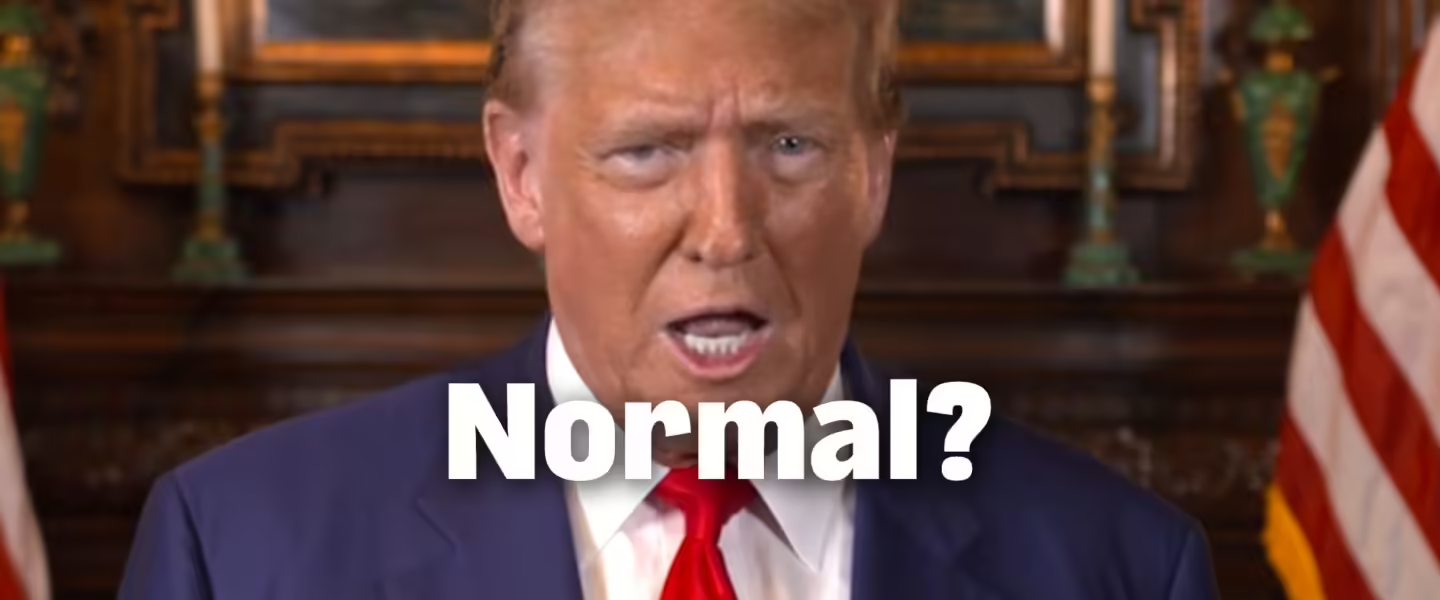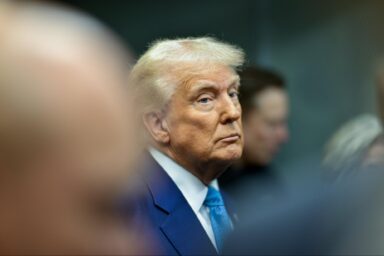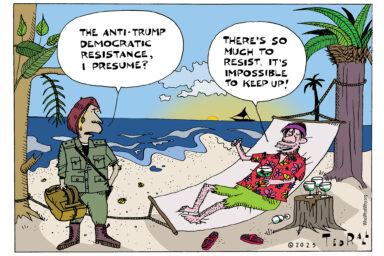The comment that stopped me in my tracks.
|
Listen To This Story
|
I so agree with Molly Jong-Fast that we can not allow the anti-democracy extremism of Donald Trump and his cultists to become normalized — by the media, or anyone else.
Every day, as she points out, coverage of specific events or the overall framing of today’s politics normalizes far too much of it:
The media needs to call a lie a lie, and not worry if doing so appears partisan, while making clear that Trump’s authoritarian agenda would mark a radical break from America as we know it. This isn’t just another normal presidential race.
But… I want to add a perspective someone shared with me a few years ago — that both complicates what she is saying but also makes it even more urgent.
As context, know that I’ve been saying something similar for years: that none of this is “normal.” And I once said this forcefully to a group of college students I was addressing in Columbus, OH.
It was 2016, just a few months before Trump won (when most still didn’t think he would). Still, from the moment he went down that escalator, to those truly bizarre debates, to open misogyny, to the rallies that got wall-to-wall coverage, to the proposed “Muslim ban,” to asking Russia for help, and so much more, the campaign had already taken countless disturbing and dark turns. Chaos I had never seen before.
Alarmed by it all, I said to this group of young folks (looking back, they all were probably born around 1995-1998), with gusto: “Just so it’s clear, none of this is normal.”
When I said it, I didn’t expect it to be disputed. But then one of the students — a young African American woman — raised her hand. She didn’t ask a question. Instead, she offered a polite correction.
“Mr. Pepper,” she said. “For us, this is normal. It’s all we’ve ever seen.”
As the rest of the room nodded, I went quiet. Rare, I know!
And as she finished her sentence, and as I did the math in my head (of what these young people had all seen at what age), it was clear how right she was. And I’ve never forgotten those words since.
My Normal Not Their Normal
There I was, carrying on about how not “normal” it all was (and is), without realizing that for younger generations (her age and all those after her), all this crazy and awful and “not normal” politics is all they’ve seen and known politics to be. It is their normal!
Think about it.
Since that young woman and her fellow students were around 12, the birthplace (and legitimacy) of the sitting president had been questioned owing to the color of his skin. And the guy who had led that conspiracy theory was, at that moment, on the verge of being president. Then that group would watch him become their president — kicking off with that atrocious inauguration speech and only going downhill from there — until they were in their mid-20s.
“For us, this is normal. It’s all we’ve ever seen.”
Now think about the young people born five or so years after that group — now voting in their first or second presidential election.
Since they were 12 to 14, Trump has either been president, or — even after he lost — his far-right politics (including an attempted insurrection) have continued to dominate the scene. This includes calling human beings “animals,” promising to be a dictator on Day 1, admiring other nation’s dictators, and open racism he’s unleashed across the country. And amid all this, he absolutely crushed his GOP primary opponents to emerge as the GOP candidate again. All as millions cheer for it.
They’ve also watched as America’s system of justice seems unable to hold him accountable, including for that insurrection. That too is their normal.
At a more personal level, in contrast to almost everything most parents tell their kids as they grow up, they’ve watched Trump do the opposite… and appear to succeed because of it. Again, it’s all cheered. Mimicked.
https://twitter.com/NesEvan9/status/1746811145401639170
Three Shows Then, Chaos Now
“For us, this is normal. It’s all we’ve ever seen.”
But this goes beyond Trump.
Look more broadly at the political environment now, versus what you saw in your younger years (it will vary, I know). What politics looked like then (not to insiders, but for those of us who were outsiders), and what it looks like now.
When I think back to my young years — say high school — most of my politics involved watching three major political shows on television, which aired once a week. On Sunday mornings.
Many of you will remember: To get your political fix beyond your local paper (The New York Times and The Washington Post didn’t go national until later), you watched one of those three shows (Sam Donaldson and Cokie Roberts, or their predecessors; Tim Russert or his predecessor; the CBS show). An hour or two a week.
And the shows were calm, because the hosts were calm (Sam and George Will were sort of the “wild” ones back then). The guests were generally calm — Sens. Warren Rudman and Tim Wirth, Sam Nunn and Pete Domenici, John McCain and John Glenn. Elizabeth Dole. It was like a civil conversation was taking place in your living room. If you dared to lie, or tried to change your position without being honest about it, you had violated a major norm, and Tim Russert or his colleagues would make that clear.
Then around 11:30 or noon, the shows would end, you’d go back to other stuff, and the next Sunday, you’d catch up on politics again.
For many of us, at least, politics came in those calm, slow doses on those Sunday shows.
This will make me and some of you sound old, but not only was there no Fox News, there was no cable TV! There was no internet. There was no social media. There were those three Sunday shows.
Now think about that young woman who corrected me in 2016.
What have she and those even younger experienced?
Politics has been 24/7 chaos for as long as they can remember — not just on TV and cable, but on their phones, computers, tablets, radios, podcasts, social media feeds, and so on.
Add all these outlets up and you not only can’t keep up with who the guests are — you can’t keep up with who all the hosts are. Or the influencers or the tweeters or the posters. And whether host or guest or influencer, many seem to get ahead by conducting the opposite of that calm conversation between Tim Russert and Warren Rudman — mostly by being as over-the-top as can be. Even politicians like Ted Cruz have their own podcasts; it’s like the political job is simply the pathway to a bigger social media following.
And most of it doesn’t involve a conversation at all. Viral videos, tweets, cable shout-downs, and the like. And unlike those Sunday shows, you can’t turn any of it off.
And in this new age, the loudest and most audacious get most of the airtime. The more quiet public servants — the old “normal” — hardly merit any attention at all. Actual policy deliberation and public outcomes — again, the old “normal” — are replaced by accusations and rhetoric that rarely involve actual issues.
Three calm shows versus all that chaos.
Add it all up and, if you’re 20 or 25 today, watching Sens. J.D. Vance and Ted Cruz and Josh Hawley, not to mention Vivek Ramaswamy, rise to high heights by doing little to no service (and hardly pretending to) while making tons of right-wing noise (including changing their views on a dime), you’d be excused for thinking that politics today has absolutely nothing to do with public service. It’s just a wild, nasty, ugly free-for-all — nothing to do with service and everything to do with extremism and power and endless disrespect for others.
You’d also be forgiven for believing that idle talk of civil war and defying election outcomes, open talk of violence and racism, and conspiracy theories like replacement theory and rampant voter fraud by voters of color are all part of usual political discourse. Because all of that poison and bile have permeated politics since you came of age.
“For us, this is normal. It’s all we’ve ever seen.”
So our challenge goes beyond simply not normalizing Trump’s current wave of disturbing and anti-democratic behavior.
Once you listen to what that young woman told me — and realize her insight applies to all who’ve come of age since — you see we have a far higher hill to climb.
We have to convince an entire generation of Americans that there is — that there can be — a different normal from the one that’s been baked in for most of their lives.
While we look back and remember a normal we may want to return to, they’ve never seen it or experienced it. Their lived experience is that it doesn’t even exist.
If they’re seeking normal, at least, politics and even democracy are not where they’re going to find it.
Finding a New Normal
One other thing: Time is of the essence.
As every year goes by, the “normal” we once experienced fades further into the past — forgotten. And every year, millions more Americans will have experienced only the chaos of today as their “normal.” Not knowing it can be better, many won’t expect or demand anything better going forward.
Those of us who know only have so much time to show these younger generations that there was once a different normal, which can be again.
But there’s one other caveat.
While someone like me may look back at those old days in the TV room and recall a better, calmer “normal,” we’re not going back to that either. Nor should we try.
If you look at the people I listed as part of that old “normal,” you’ll see it’s mostly male and mostly white. And as I look back at my own young life, I viewed it all and felt comforted by it all from my own privileged position.
I know now that beneath that surface of “normal,” many Americans were struggling, many policies were dividing people, other policies were holding people back, and many voices were left out. That old “normal” also played a role in sanitizing realities and wrongs and injustices that needed more exposure, more animated discussion, more solutions.
So our answer can’t just be to pine away for the old normal.
It’s to create a new one.
Of course, a dramatically better “normal” than what young Americans have experienced, but also a better, more open, more honest and more inclusive “normal” than the one I experienced growing up.
That honesty will necessarily make it more spirited — more challenging and complicated, and real — than what I saw on those Sunday mornings, and that’s only healthy.
And it also can be a normal where politics is indeed about public service. About solving problems. About lifting people. That’s why you enter it, and that’s the work you do when you get there.
It must be a normal that adheres to the principles of a rule-of-law democracy, truth, and respect for fellow Americans. Which means that Trump’s dangerous talk and actions — pushing authoritarianism, lies, lawlessness, racism, misogyny, exclusion, and division — are all viewed (again) as way out of bounds, and called out as such (just as Molly Jong-Fast wrote). And one where attacks on freedom and core American principles are viewed as disqualifying for public office.
But also, more than the one I experienced, it can be a normal not just of surface-level civility, but of humanity. An open and honest addressing of problems and injustices in our country by the broad and diverse voices that make up our country — and not a sanitized conversation while those issues go unaddressed and too many voices aren’t part of the conversation.
“Mr. Pepper, for us, this is normal. It’s all we’ve ever seen.”
She’s right.
The clock is ticking. Years are passing. As memories fade, today’s normal is cementing into place for millions.
Let’s get to work creating something far better.
David Pepper is the former chair of the Ohio Democratic Party, author of several political thriller novels as well as nonfiction works, and writes the Pepperspectives substack, from which this column was reprinted with his permission.




